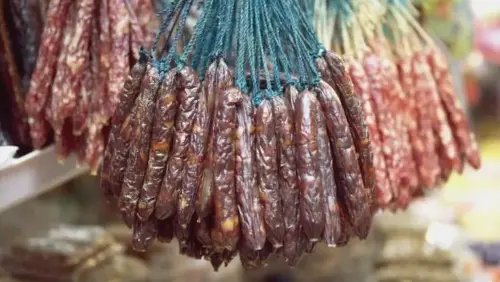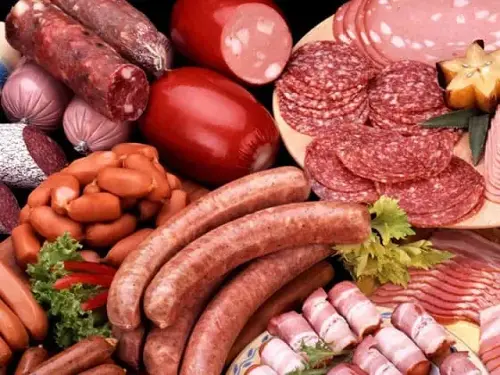Nitrates and nitrites are not only found in drinking water and vegetables, but also in processed foods. Nitrates not only increase the risk of poisoning, high blood pressure, destroy vitamins, and increase the risk of cancer, but also increase the risk of cancer. So how can we prevent nitrates from entering our bodies?

Some processed meats contain nitrites – Photo: BBC
Substance found in many foods
Prof. Dr. Nguyen Ba Duc, Vice President of the Vietnam Cancer Association, said that recently many N-nitroso compounds are known to be carcinogenic in humans and animals. People are concerned that nitrites from processed meats, nitrates in vegetables and nitrosamines, N-nitroso (nitrites combined with amino acids in food) have the risk of causing cancer.
High levels of nitrosamines can easily be eliminated by the body, and long-term accumulation in the liver can cause poisoning or even liver cancer, stomach cancer, and esophageal cancer.
Nitrates and nitrites occur naturally, and meat preservatives and other processed products such as butter, cheese, and beer may also contain soluble nitrosamines.
Doctor Tran Anh Tuan, Hung Viet Oncology Hospital, said that natural nitrates are found in plants, and the concentration varies depending on soil conditions and the amount of fertilizer used.
Between 5 and 20% of dietary nitrate is converted to nitrite, which is found in some vegetables (such as potatoes). Nitrites are sometimes used to preserve processed meats and fish (they are toxic to bacteria) and to give processed meats and fish their characteristic color.
The nitrates from these food additives account for about 6% of the total nitrates we are exposed to in our diets. Products containing relatively high concentrations of nitrates include:
– Ham: Usually the highest source of nitrates in the diet. A 100g serving of cured ham has up to 890 mcg of nitrates.
– Bacon: Bacon has up to 380 mcg of nitrates per 100g of weight. Nitrates and nitrites tend to be common in bacon production, but some brands label their packaging as nitrite-free. Check, though.
– Frozen meat: Frozen foods are a harmful source of nitrates. On average, processed frozen meat has up to 500 mcg of nitrates per 100g of meat, while uncooked cold cuts have about 300 mcg in the same amount of meat.
- Sausage is one of the most widely available processed meat products on the market. The average sausage contains about 50 mcg of nitrate per 100g of meat, carrying about 9 mg of nitrite.
In addition, the body receives nitrate from drinking water, some vegetables have high nitrate content. Nitrate from drinking water accounts for about 21% of the total nitrate that an average person absorbs through daily diet.
The reason nitrates contaminate water sources is due to the overuse of inorganic fertilizers in agriculture. Agriculture and waste from industry.
70% of the nitrates absorbed by the body come from vegetables. So far, the reason why some vegetables contain high nitrates is still not really clear, but there are 3 related factors: genetics, lighting or living environment and nutrition.
Genetics is an important factor and the ability to accumulate high nitrates only occurs in a few vegetables such as cauliflower, cabbage, broccoli, lettuce, peas, carrots, beets, etc.

Processed foods contain a lot of nitrates and nitrites, so use them sparingly - Illustration photo
How to avoid taking large amounts of nitrates to prevent illness in the body?
Experts say that nitrite and nitrate are toxic substances to living organisms and humans because the metabolic products are nitrosamines that can be toxic to fish and shrimp and cause diseases in humans. In fact, nitrate in food is usually not toxic, but when entering the body, nitrate is converted into nitrite, which is toxic.
Under certain conditions, nitrate can be converted to nitrite by intestinal bacteria. Nitrite has the effect of oxidizing hemoglobin (hemoglobin) contained in red blood cells, turning hemoglobin (Hb) into methemoglobin (MetHb) which is unable to transport oxygen and carbon dioxide, leading to a lack of oxygen in the body.
When poisoned by nitrite, the body will not be able to complete its respiratory function, with symptoms such as difficulty breathing, cyanosis, respiratory failure. In particular, nitrite also destroys some vitamins of group A and B such as B1, B2. When the nitrate content is from 19 - 125ppm, it will increase blood pressure. Nitrite is also the cause of some food allergies.
To avoid disease-causing nitrates and nitrites, it is necessary to limit foods containing high levels of nitrates and nitrites in meals and avoid taking large amounts of these substances into the body. In particular, young children are susceptible to nitrate poisoning because their intestines are less acidic, so nitrates convert to nitrites more quickly.
Furthermore, young children do not have enough enzymes in their blood to convert methemoglobin back into hemoglobin. Children with this condition often appear pale and have poor health.
Therefore, children should not eat too many foods containing nitrates, and should not use water boiled from vegetables containing a lot of nitrates or well water (a water source with a high risk of nitrate contamination) to mix milk.
Pregnant women should also avoid eating foods high in nitrates. When choosing processed foods, avoid products containing additives containing nitrates and nitrites such as potassium nitrate, potassium nitrite (salt pepper)...
Foods to limit
– Processed meats such as cold cuts, bacon, sausages… They can increase the risk of colorectal cancer if eaten too often.
– Foods high in saturated fat can contribute to weight gain. Being overweight increases the risk of many types of cancer.
– Alcohol can increase the risk of mouth, throat, esophagus, liver, breast, and colorectal cancer. Men should not drink more than 2 drinks per day. Women should not drink more than 1 drink per day.
Sources: https://tuoitre.vn/cach-phong-ngua-nitrat-trong-thuc-pham-vao-co-the-tranh-benh-tat-20241106074943037.htm
